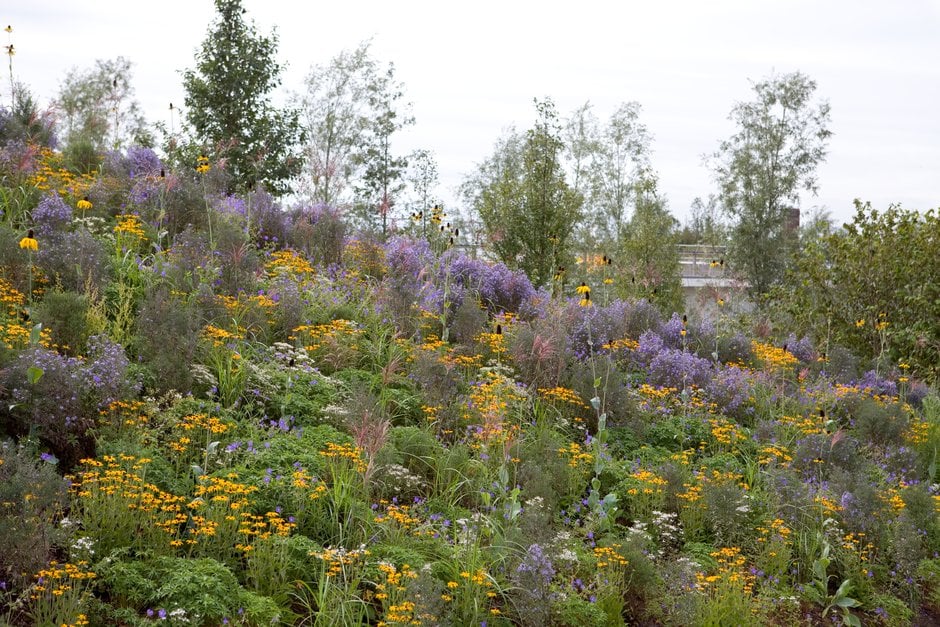Bank and ditch habitats
Banks, slopes, ditches and other undulations in the garden offer many micro-habitats for wildlife and give added interest to a garden.

Quick facts
Sloping places wildlife finds a home;
- Sunny slopes are good for basking butterflies
- North and west-facing slopes seem to be favoured by glow worms
- South-facing banks make excellent nest sites for mining bees
- Shady ditches favour mosses and amphibians
Banks and slopes
A bank or a slope will tend to be free-draining, though its conditions will depend on which way it faces; those facing south and west are usually warm and sunny; those facing north and east cool and shady.
In farming it’s good practise to make ‘beetle banks’ between fields which help harbour natural predators for the crops; these banks help restore some of the habitat for beetles that hedges would have provided when field sizes were smaller and before many hedges were grubbed out. The banks are simply a tussocky ridge, left undisturbed. In a garden you may have something similar, perhaps a grassy bank above or below a mown lawn. If the grass is allowed to grown long, this will provide plenty of invertebrate cover. Even mown slopes will often have some patches in them which might be used by certain mining bees such as the ivy bee to nest in. Records from the UK Glow Worm Survey indicate you are more likely to see glow worms on north and west-facing slopes compared to other aspects.
Rocky or sparsely planted banks which face the sun are good places to spot basking butterflies and lizards (including the legless lizard, the slow-worm) on a sunny day in spring or summer. Other pollinating insects will be attracted if plants such as bird’s foot trefoil (Lotus corniculatus) and clover are planted. Try planting a
Shadier banks covered in low-growing shrubby plants such as periwinkle (Vinca), ivy (Hedera) and bramble give opportunity for birds to nest and shelter in. Primroses (Primula vulgaris) and celandines (Ranunculus ficaria) add spring interest.
Take a look at our RHS Guide on steep banks and slopes for more planting ideas.
Steep banks and slopes
Ditches
A garden might have a ditch at a boundary or the bottom of a slope to help with drainage. Their sunken shape and tendency to channel rainwater means they are usually damp, cool places for wildlife, even if they don’t permanently hold water. Plants that grow in them are unlikely to catch a lot of sun so ditches will favour shade-loving plants such as mosses, ferns and ivy.
The year-round damp nature of a ditch means it is an ideal spot for frogs, toads and newts. Outside of the breeding season amphibians can spend much of their time on land, seeking hunting opportunities among humid vegetation. With porous skin, prone to desiccation, they can’t afford to dry out. Slugs, snails and many other invertebrates such as ground and rove beetles, millipedes, woodlice and springtails abound in damp leaf litter and among foliage.
Add shade-tolerant plants if your ditch is unplanted. Gravity-defying ferns such as harts tongue fern (Asplenium scolopendium) can be tucked into the steep sides of a ditch. Other plants to try include lady’s smock (Cardamine pratense), saxifrage and Tellima grandiflora.
Unless your ditch is needed to be kept clear to channel water away, pile up some dead logs in the bottom to create even more habitat. Very steep-sided ditches can trap hedgehogs so be sure to install a sloping ramp out of a plank of wood covered in chickenwire or a series of logs.
Try building one
If your garden lacks banks or ditches, why not try building one. In fact, if you are excavating soil to make a ditch, simply pile it up on one side of the ditch to create a combined ditch and bank in one go! As most gardeners know well, the shorter the distance you have to move soil, the better.
There is no ‘perfect’ size for such a feature but to be sure of creating novel conditions (and hence a new micro-habitat) it makes sense to make your ditch or bank at least 30cm (1ft) deep or tall. On lighter soils, hand digging with a spade is hard work but effective. Heavier soils and bigger projects may require you to hire a mini-digger (with operator) but try not to work on heavy (clay) soils when they are wet as this will cause them to compact. Check first if there are any underground service pipes that you might need to avoid if digging in that area.
Banks and ditches are often linear features, but they don’t need to be. If you are on an exposed, windy site, create a crescent-shaped bank facing away from the prevailing wind to maximise shelter on the inner slope. And if you’re concerned about crossing a ditch to get to another part of the garden, build a bridge or two out of railway sleepers or similar.
Get involved
The Royal Horticultural Society is the UK’s leading gardening charity. We aim to enrich everyone’s life through plants, and make the UK a greener and more beautiful place.